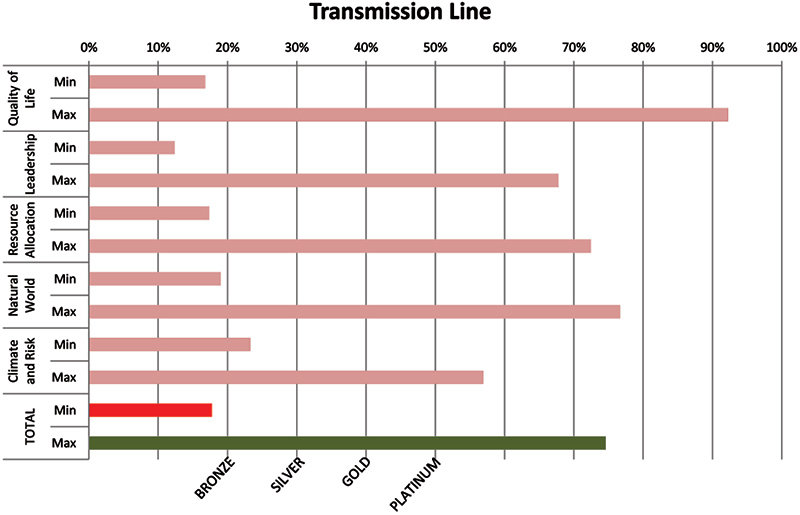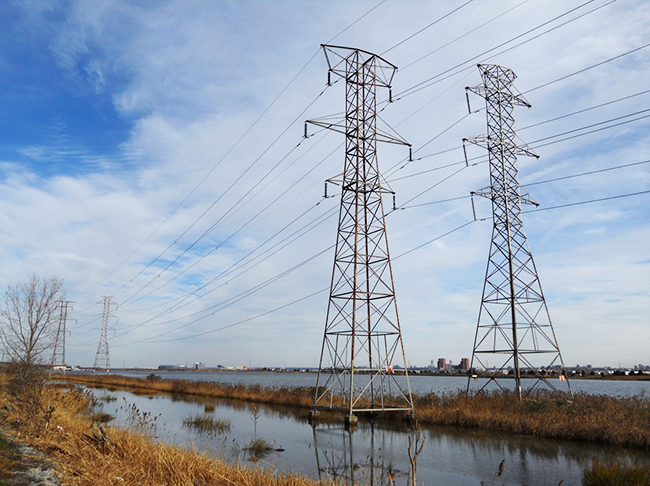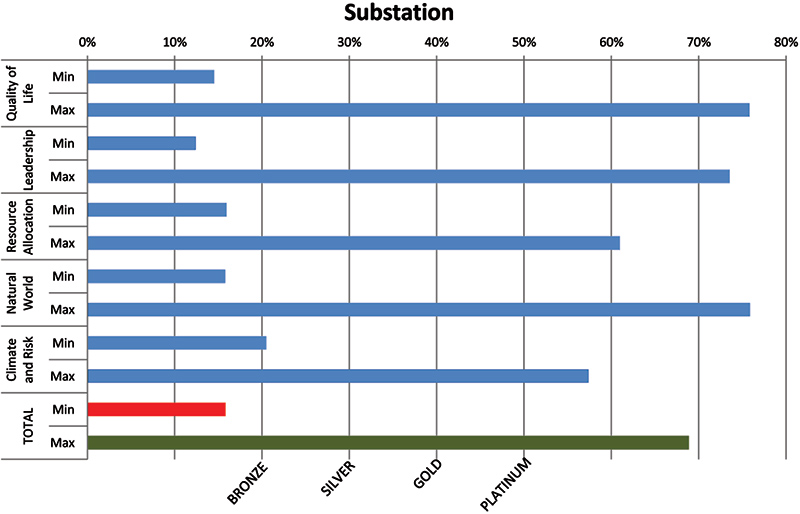Utilities are entering an era of change that could significantly enhance the sustainability of the projects we build. Stakeholder involvement and demands for more sustainable business practices are becoming more important, and for good reason. The population is currently depleting more natural resources and creating more pollutants than the Earth can sustain. Not only are resources becoming scarcer, but also the challenges and demands are becoming greater. Populations demand more power and more reliability, while the changing climate and severe weather systems result in greater strains on the aging grid. The path forward must change or the consequences for future generations could be drastic. The solutions will not always be easy, but with new tools like the Envision™ rating system assisting in the process, we can improve the quality of our practices.
State of Infrastructure
United States infrastructure was given a D+ rating (‘poor’) in 2013 by the American Society of Civil Engineers. A majority of infrastructure sectors in Canada received ‘fair’ to ‘very poor’ in 2012 on the Canadian Infrastructure Report Card. In America alone, it is estimated that US$3.6 trillion is needed to be invested by 2020 just to get the infrastructure up to passing grade. In an age of reporting, transparency, and consumer relations, taxpayers and stakeholders will demand their money is being spent appropriately and efficiently. Company and utility reporting, such as the Global Reporting Initiative,™ provide methods to assist these entities in conveying to the public and stakeholders how they are implementing sustainable business practices. Many Fortune 500 companies are voluntarily deciding to participate in reporting because they know it adds value to their company. Those that aren’t participating could likely be required to in the future. Indexes such as the Dow Jones Sustainability Index assess and value companies based on their commitment to this principle. Many individual corporations, such as Wal-Mart, have their own internal sustainability indexes and measuring tools. The Envision™ rating system can provide the guidance and framework to help utilities also achieve these business practices.
Enter Envision™
In 1998 the Leadership in Energy and Environmental Design (LEED) rating system was developed by the United States Green Building Council (USGBC) to drive sustainable building design. To date, LEED has been applied to over 7,000 projects in more than 30 countries. It is the most accepted and successful green rating system on the market, setting the bar for all rating systems to follow in the coming years. Inhabited buildings were always the main target for LEED, leaving a major gap for civil infrastructure among other sectors. In 2012 the Institute for Sustainable Infrastructure (ISI), in conjunction with the Zofnass Program for Sustainable Design at Harvard, developed the Envision™ rating system to fill this gap. Utilities, public works, and civil infrastructure companies now had their answer to LEED. This isn’t just a rating system to give recognition however, it is a design tool meant to provide guidance from concept to finished project.
Envision™ provides new guidance and metrics to gauge the sustainability of an infrastructure project by evaluating the contributions to the following five categories: Quality of Life, Leadership, Resource Allocation, Natural World, and Climate and Risk. The ultimate goal is to reduce, or in some cases reverse, the negative impacts created by a project. It has been designed to encompass all types of civil infrastructure, including transmission lines and substations. Previous rating systems have not covered all types of civil infrastructure, likely hindering the sustainable design development of the utility industry over the past decade or more due to lack of visibility, opportunities and incentive. Envision™ provides utility companies an opportunity to enhance project performance and sustainability without a major sacrifice to schedule or budget.
Opportunities for Utilities
While opportunities exist for new design and planning strategies, many utilities are already employing certain measures that fall within the best practices envelope. Many credits focus on stakeholder involvement and reducing negative impacts to the community, which is common practice for utilities on the front end of projects. Other credits may involve more extensive documentation and front-end work to earn points. If adopted during the early planning stages, it is anticipated that most projects can confidently earn lower-tier rating levels without making major adjustments to the standard project process and design. Projects that have complete team commitment at the earliest stages of the project, strive for innovative solutions, and target higher credit levels could earn top-tier rating levels (e.g. Platinum or Gold).
Below is a chart reflecting anticipated point total ranges for low-achieving and high-achieving transmission and substation projects. As detailed in the figure below, the delta between high- and low-point totals is significant, indicating the great opportunity for high-performing projects. Some progressive utilities even want to see these kinds of studies conducted for past or current projects to give them an idea of how they are doing and where they can improve once they fully engage in the Envision™ process. The tool is readily available online to help companies evaluate a project that has already been completed.

Figure 1 – Anticipated Utility Project Envision™ Credit Levels
At their core, all civil infrastructure projects are intended to provide for the health, safety and welfare of the population. Throughout history however, public infrastructure projects have not always been kind on the environment. It should not be a surprise that the credit categories – Quality of Life and Natural World – contribute the two highest point totals to the overall total upon which the project is rated. Utility projects have potential to score very high in both of these categories. Increased power transmission and distribution can improve community quality of life, stimulate growth and development, and build local skills. Not all credits in Quality of Life reflect what the project will change or affect, but rather how the project will minimize or preserve. Utilities must focus on ways to preserve views and local character for example, while still managing to provide reliable electricity. Natural World credits also largely reflect how the project can reduce, avoid, protect, preserve, and control. New transmission lines and substations are largely built on undeveloped land, or green fields, meaning the impact to the natural world can be great. Transmission projects on occasion cut through farmland, forests, and other areas that can naturally create strong opposition among the public. Utilities are well aware of the efforts needed to optimize the route and engage the public. This is never an easy or cheap process. The Leadership category of Envision™ will help utilities engage the public early and often, and to foster a collaborative environment between the parties involved in the project. It is no secret that transmission lines and substations are not always popular among neighbors. Obtaining a shiny Envision™ Certified plaque for the project may not appease everyone, but at a minimum a utility can point to all the efforts undertaken to build a project that did everything feasible to result in a positive triple bottom line (economic, social, and environmental).

Rising waters and other charges in our natural world will provide increasing challenges for utilities.
Implementing the Envision™ Tool
In order to be most efficient, the utility needs to bring on one or more Envision™-credentialed team members (ENV SPs) that will guide the project through the process from concept to finished project. ENV SPs earn their credentials by completing training modules and taking an online test that reviews the credits and intent of Envision™. It is a requirement that a project applying for certification must have an ENV SP on the team. This team member will assist the group in assessing every portion of the project in hopes that it will extend the longevity of the infrastructure while reducing impact. The first project was not certified until late 2013, meaning that no project has been brought from concept to finished product under the framework by an ENV SP, thus the full intent of the system has yet to be realized.
The cost of incorporating Envision™ into a project is anticipated to be low – compared to the overall project cost – and it should not significantly affect the project schedule. Utilities often focus on the upfront cost, but the ENV SP team members will try to assist them in looking at the project through different lenses regarding cost. Many hear the word sustainability and first associate the concept with cost. Companies around the world, including utilities, have proven that sustainable design can be accomplished while maintaining top-tier economic (and social) performance. In the 2013 Dow Jones Sustainability Indices, an energy company by the name of Energias de Portugal SA (EDP) was the utility industry group leader. It is no coincidence that EDP has a long history of sustainability initiatives and proactive approaches. These business practices are pervasive among the group’s management; in fact, EDP monitors and evaluates their own ‘Sustainability Index’ on a quarterly basis. As seen in the following graphic, EDP does not seem to be underperforming due to this business model which has evolved over the past few decades. Rate payers and stakeholders are beginning to demand these sustainable business practices from their utilities, and Envision™ will not only assist in these practices, but also provide recognition for their efforts.

Figure 2 – Dow Jones Sustainability Index for Top Utility Group Energias de Portugal SA (Courtesy of Dow Jones Sustainability Indices)
Changing the Status Quo
Recent changes due to the Federal Energy Regulatory Commission (FERC) 1000 order may shake up the industry, notably to the right of first refusal policy. “The rule also promotes competition in regional transmission planning processes by removing from FERC-approved tariffs and agreements a federal right of first refusal for transmission facilities selected in a regional transmission plan for purposes of cost allocation,” stated former FERC Chairman Jon Wellinghoff in a 2011 press release. Now that utility companies will not get first shot at all projects within their region or service area, they will inevitably see more competition from innovative developers and other utilities. The overall goal is to keep increasing reliability for existing customers while delivering low-cost power to new markets, including renewables. Envision™ will help utilities provide the value to keep growing their business and stay competitive in this changing landscape. Creativity and innovation will happen at the front end of the planning process. In the past, utilities might not have always been addressing the right project, which is something that the system also strives to address. Perhaps the solution is not a new 60-km transmission line, but higher capacity storage or a micro-generation unit. Utilities should not only be asking if the project is done right in the end, but also if this is the right project to begin with.
Moving forward as a society, the electric grid is arguably the most critical component of public infrastructure. So many things people do every day are entirely dependent upon being able to plug into an electric outlet. The design of the electric transmission infrastructure system needs to be progressing and innovating at a comparable pace as the rest of society. Much of transmission and substation infrastructure has outlived its useful life and is based on very mature technologies that have changed little over the years. Ample opportunity exists for innovation in many areas within electric transmission, and specifically in the area of environmentally conscious design. The competition created by FERC 1000 highlights and emphasizes these opportunities and incentivizes stakeholders to take advantage of them. The future is very bright for stakeholders involved in the transmission and distribution industry. As more and more opportunities present themselves, innovation is a natural by-product. The opportunities in the sustainability arena are clear. The rating system has already created a program that guides a project in the direction of a more sustainable product. Emphasis on sustainability is a valuable and noticeable way to stay ahead of competition, satisfy shareholders, and add value to business. The Envision™ system is a tool to guide utilities down the path to achieve that value.
About the Author
 Will Kirby is a Staff Transmission Engineer in the Transmission & Distribution global practice at Burns & McDonnell. He has almost five years of experience at the company working on overhead transmission and distribution line design. Will earned Bachelor of Science degrees in Civil Engineering and Architectural Engineering in 2008 from Missouri University of Science & Technology and is a registered professional engineer and an accredited Envision™ Sustainability Professional. Will has been working on sustainable design studies and efforts for the past three to four years.
Will Kirby is a Staff Transmission Engineer in the Transmission & Distribution global practice at Burns & McDonnell. He has almost five years of experience at the company working on overhead transmission and distribution line design. Will earned Bachelor of Science degrees in Civil Engineering and Architectural Engineering in 2008 from Missouri University of Science & Technology and is a registered professional engineer and an accredited Envision™ Sustainability Professional. Will has been working on sustainable design studies and efforts for the past three to four years.








